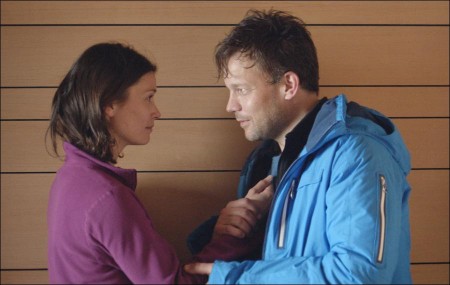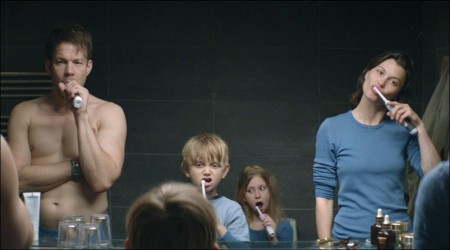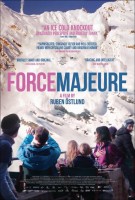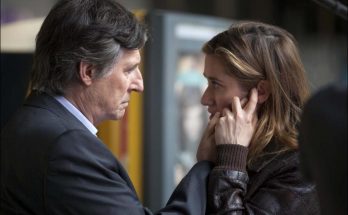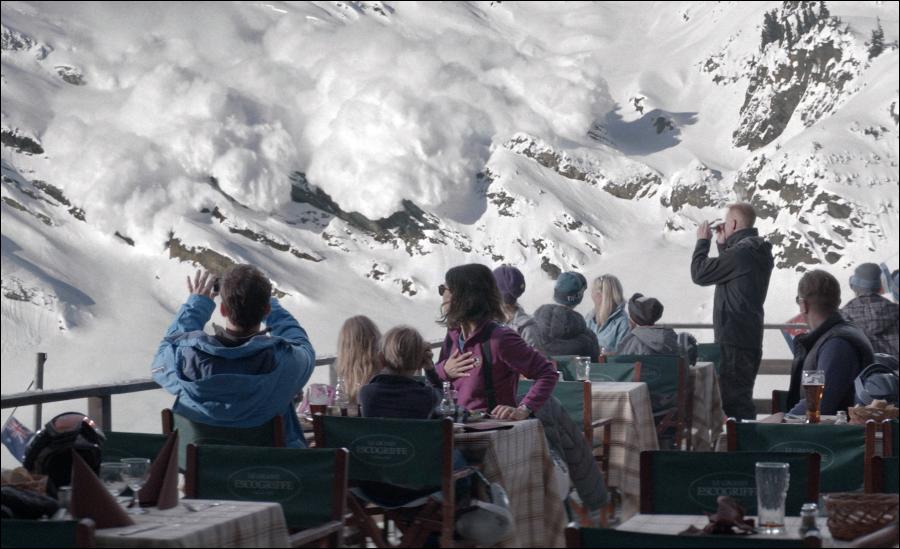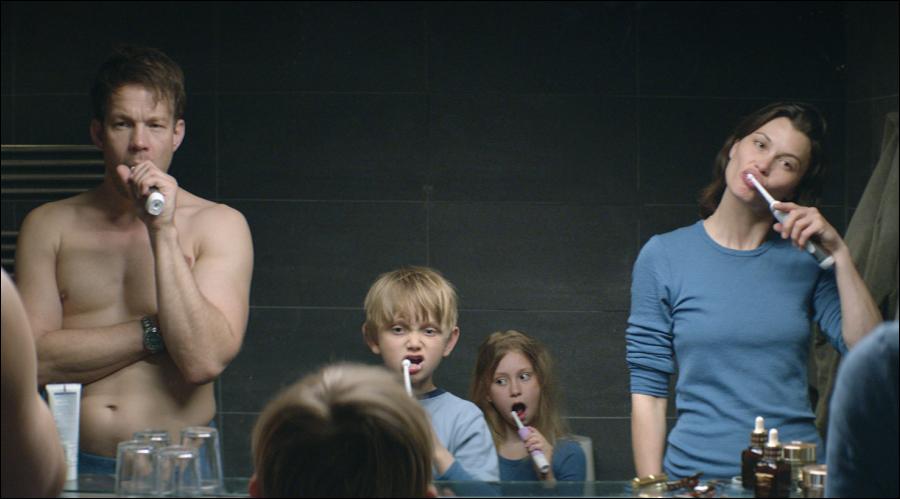A critical favorite at this year’s Cannes Film Festival, where it took the Jury Prize in Un Certain Regard, this wickedly funny and precisely observed psychodrama tells the story of a model Swedish family—handsome businessman Tomas, his willowy wife Ebba and their two blond children—on a skiing holiday in the French Alps.
The sun is shining and the slopes are spectacular but, during a lunch at a mountainside restaurant, an avalanche suddenly bears down on the happy diners. With people fleeing in all directions and his wife and children in a state of panic, Tomas makes a decision that will shake his marriage to its core and leave him struggling to reclaim his role as family patriarch.
Director’s Statement – Ruben Östlund
Force Majeure has its origins in a question I have long been fascinated by: How do human beings react in sudden and unexpected situations, such as a catastrophe? The story concerns a family on holiday that witnesses an avalanche and the father runs away, terrified. When it is over, he is ashamed because he has succumbed to his primal fear.
This particular story came about from an anecdote that I found impossible to forget. Some years ago, a Swedish couple—friends of mine—were on holiday in Latin America when suddenly, out of nowhere, gunmen appeared and opened fire; the husband instinctively ran for cover, leaving his wife unprotected. Back in Sweden, she could not stop, after a glass of wine or two, telling the story over and over again…
My imagination fired, and I began to research other true stories like this one – stories of distress and emergency, of passengers during the sinking of ships, of tourists stricken by tsunamis or held hostage by hijackers. In such extreme situations, people can react in completely unexpected and exceedingly selfish ways. It appears there are scientific studies on the subject – that in the aftermath of a catastrophe, a hijacking or a shipwreck, a large number of the survivors divorce.
It also appears that, in many cases, men do not act according to the expected codes of chivalry. In life or death situations, when their very own survival is at stake, it seems that men are even more likely than women to run away and save themselves, which may be the chief cause for those divorces. This made me want to explore the notion that a man is supposed to be the protector of his wife and family, the societal code that says he must not step back in the face of danger.
From here, I arrived at the concept of an existential drama in a ski resort, something that appeals to me greatly. Ski holidays contribute to the feeling of having full control over one’s own life. Like most European ski resorts, Les Arcs, where FORCE MAJEURE was shot, was built in the 1950s to receive middle-class families consisting of an executive father (sometimes working) mother and two kids. The father is supposed to muck in, the fully equipped open-plan kitchens in the ski apartments giving the mother a chance to do things other than cooking, like ski with her family, or relax.
Ski resorts are meant to be cozy, as the advertising shows—we can imagine the woman relaxing, her husband playing with the kids. Vacation is a time when the Western middle-class father “pays back” the family for his absence. It is an opportunity for him to devote time to his children and take care of them. But in Force Majeure “Civilized Man” is confronted by “Nature.” The characters experience this drama, and the father, Tomas, must face the savage part of himself, because his instincts lead him to save himself and abandon his children and his wife. He must face the reality that he, too, is subject to the forces of Nature, and that he has failed to conceal his most basic human impulse – the survival instinct.
After the panic of the avalanche, our characters manage to raise a nervous smile, get back onto their feet and brush off the snow. But although no physical damage has been done, the family bonds have been shaken to their core; slowly, they will begin to ask themselves questions about the roles they believed they played so well, they will have to deal with this new image of Tomas, who did not act as was expected. Tomas himself must also reconcile his actions with his self-image, and his wife, Ebba, must admit that her husband and the father of her children abandoned them at the moment when they needed him most.
This particular situation illustrates the wider existence of specific mutual expectations between the members of a family, even if these assumptions are seldom voiced. Each person has a role to play and one expects the others to perform according to their given role. Perhaps unconsciously, most people expect the mother to take care of the children on a daily basis, whereas the father has to stand up when a sudden threat is coming. Yet nowadays a man very rarely has to stand up and protect his family.
He has no practical opportunity to express this kind of action, because there is so little physical danger in Western middle-class society. But everybody still expects it from him—he even expects it from himself. That interests me, this expectation, as does the fact that it is disconnected from reality – that statistics show a man is more likely than one thinks to abandon his family in a crisis. Investigations of catastrophes at sea have shown that the percentage of male survivors is higher than that of female survivors.
The avalanche scene in Force Majeure is genuinely frightening. It was shot in a studio where a part of the restaurant terrace was reconstructed in front of a green screen, composited with footage of a beautiful avalanche shot in British Columbia and with digital snow mist added to the scene. During the post-production of this and some other shots, I applied effects and/or camera movements using Photoshop and After Effects as I had previously done with PLAY and INVOLUNTARY and most notably in the short film INCIDENT BY A BANK, in which all the camera movements were created during the editing process.
FORCE MAJEURE takes place in a majestic visual environment that I wanted to enhance further through CG, “rebuilding” mountains and portions of the hotel complex to create a truly sensational feeling. Of course, as was the case in my previous films, digital work remains completely invisible, leaving audiences without any clues that the environments have been touched.
We shot the film with anamorphic lenses, using the ARRI Alexa camera, after cinematographer Fredrik Wenzel and I had done a variety of tests. These lenses lend a more cinematic feel to the film and allowed us to achieve a truly epic sense of framing in the mountain environment. They also bring us closer to the characters than in my previous feature film PLAY; we were able to get close-up shots whilst still having some background to work with.
The structure of the film follows a regular ski week schedule—first day, second day, third day—until the family goes back to the airport on the fifth day. The family dynamic is developed on the first day, with the gorgeous setting, the mountains, and the great weather. The incident with the avalanche then occurs on the second day. On the third, fourth and fifth days, we see how the family is trying to handle the consequences of the avalanche. This five day structure will allow us to repeat several elements of each day’s routine—daily breakfast, brushing teeth at night—in order to follow the evolution of the family’s behavior before and after the incident.
In FORCE MAJEURE we follow Ebba and Tomas in their journey, see the evolution of their feelings and their perception of events, witness them struggle to get back together, and share their sorrows and their hopes. The appeal for the audience is much more connected to emotion than in my previous, more conceptual films.
In the final scene, as our main characters return to the airport by bus, the tourists find themselves standing on the side of the road not only because of the bus driver’s recklessness, but also because they let their fear get the better of them. As they walk down the mountain on foot they see the bus drive off safely, and a slight sense of collective shame arises. Yet, as they walk, this slowly transforms into a feeling of solidarity. Their social masks have crumbled away and they actually share a strong moment together.
Force Majeure
Directed by: Ruben Östlund
Starring: Johannes Kuhnke, Lisa Loven Kongsli, Clara Wettergren, Vincent Wettergren, Brady Corbet
Screenplay by: Ruben Östlund
Production Design by: Josefin Åsberg
Cinematography by: Fredrik Wenzel
Film Editing by: Jacob Secher Schulsinger
Costume Design by: Pia Aleborg
Art Direction by: Josefin Åsberg
Music by: Ola Fløttum
MPAA Rating: R for some language and brief nudity.
Studio: Magnolia Pictures
Release Date: October 24, 2014
Visits: 86

